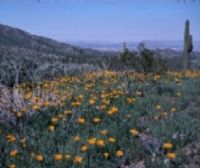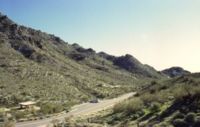The New Nature: Cities as Designer Ecosystems

PHOENIX, AZ - Urban and suburban growth has exploded in the Valley of the Sun over the past five decades, creating a playground for the rich, an attractive oasis for families, and a brand new ecosystem for plants, animals and the humans who interact with it all.
If ecosystem and city seem like oxymorons, just go deep inside this low-density metropolis and look at all the lakes and canals, the year-round greenery, the multitude of birds, or listen to the coyotes howling at night.
A cutting-edge seven-year study by more than 50 scientists from different fields has concluded that the profusion of bugs, birds and bigger creatures roaming this one-time desert outpost represent a unique realm of nature. It is designed and built by humans but surprisingly green and prolifically populated by creatures that wouldn't last a week outside its confines.
It is, the scientists say say, a designer ecosystem.
Like the rest of nature, this and other cities around the world are now being studied from an ecologist's point of view.
"People in ecology are beginning to talk about designer ecosystems - systems that have been heavily influenced by humans," says Arizona State University (ASU) professor Nancy Grimm, co-leader of new study.
Seattle, New York, Berlin ...
Sign up for the Live Science daily newsletter now
Get the world’s most fascinating discoveries delivered straight to your inbox.
New Yorkers might have a hard time imagining the word ecology applied seriously to the study of a city, unless you're talking about cockroaches, rats and salmonella.
But under the emerging definition, even the Big Apple can be thought of in ecologists' terms.
"The study of urban ecology is taking off in others cities, like Baltimore, Seattle, New York City, and especially abroad in Berlin, Sydney, and many others," Charles Redman, director of the ASU's Center for Environmental Studies, told LiveScience.
"It's not what people generally think - they think there's either nature or there are cities," Redman said. "That's what this is all about - there is nature in the city. The city is part of nature."
The greater Phoenix area, which include Scottsdale, Tempe, Mesa and several more adjoining cities that meld into one physically gargantuan metropolis, stands out in the crowd of cities now being looked at under a new theoretical and observational microscope.
The wet desert
The Valley of the Sun, as locals call the area, is crisscrossed with more canals than Percival Lowell thought he saw on Mars. Urban parks are luxuriously green, with imported plants, towering shade trees and manmade ponds and lakes. For every New York skyscraper, the Phoenix area has a golf course. Front yards flower year-round and many lawns are always green.


Credit: City of Phoenix
Amid all this, several small mountains pop up, dotted by saguaros and preserved in their natural state.
So animals flock here, creating an ecosystem that is "radically different" from the surrounding desert, the study determined.
Desert birds and other animals typically concentrate along rivers. But the natural rivers and washes that course through Phoenix are rarely wet. Instead, water is pumped in from the Colorado.
"What Phoenicians have done is to take this river, which was one localized area, and capture the water and distribute it over a very, very large area," Grimm said. "If you fly in you can see this - you can see that we have a lot more plant biomass, a lot more trees. There are little lakes scattered all over the place. Scottsdale since 1940 has gone from zero to 167 little lakes."
Good news, bad news
All this is great for the Abert's towhee, a bird you won't spot often in the desert. Canals simulate its native riverbank habitat. Ravens and peach-faced lovebirds have moved down here from the mountains. And insects abound.
In fact, birds control insect populations to an extent unlike that "other" nature, the researchers have learned.
The news is not necessarily all good, depending on your point of view.
Consider the mosquito. A person out in the natural desert or even in the distant suburbs of Phoenix would have to hire a mosquito to get bit, yet parts of the metro area last summer saw some of the highest concentrations of West Nile Virus anywhere in the country.
One reason: Some 600,000 swimming pools, not all of which you'd dare dip a toe in.
"Minnesota may be the land of 10,000 lakes, but Arizona is the land of at least 10,000 abandoned and neglected swimming pools," said Will Humble of the Arizona Department of Health Services, in an article in USA Today.
People did not just create this urban ecosystem, they are part of it, the new thinking goes.
Huge and growing
Understanding the human causes and effects in an urban ecosystem remains a challenge for the ongoing study. Unlike many cities whose populations have shrunk or been flat in recent decades, Phoenix is a laboratory of expansion, making it a unique city for this sort of study.
Last year, Phoenix proper took over fifth place from Philadelphia on the list of largest U.S. cites. In the greater Phoenix area, the population has grown from 332,000 in 1950 to more than 3.5 million today.
Researchers say they have literally watched the construction of the urban ecosystem during the study's seven years. One clear difference in the design here is population density. Philadelphia covers 135 square miles Phoenix sprawls across more than 500 square miles, not including the huge suburbs. Total: some 9,000 square miles.
In one interesting line of investigation, different parts of the metro area have totally different ecosystems based on the wealth of the residents that live there.
"The diversity of plants in the Phoenix area is related strongly to family income -- higher family income, higher plant diversity; lower family income, lower plant diversity," Grimm said. "We don't know the mechanisms, but it's an interesting phenomenon."
Can it last?
In another twist on a long-studied phenomenon, burgeoning auto traffic adds nitrogen to the local air and soil. In Grimm's parlance: "Driving around fertilizes the ecosystem."
In the old way of looking at a city, that was just pollution. In the new way, it is seen as part of the ecosystem -- for better or worse -- and it raises questions about how the design of a particular ecosystem will work out in the long run.
"What we really want to know is whether we can have a sustainable urban ecosystem in this kind of environment and setting," Grimm said. "Is the urban ecosystem resilient?"
For now, at least the coyotes seem to be doing fine. At the request of residents, local trapper Wes Patrick snared 26 of the wily creatures in the Phoenix metro area in 2004. That's 25 percent more than the previous year, he told The Arizona Republic.
Grimm and Redman have not included coyotes in their study of the designer desert ecosystem yet.
"But they probably are responding to the year around availability of food and water and accessibility of the outskirts of the city," Redman said. At the foothills of mountains surrounding Phoenix, houses that meld into the landscape are popping up like spring wildflowers after heavy winter rains. The developments, often including abundant open spaces, at once encroach on coyote territory and also invite them to wander in to look for a meal.
"What amazes me," Redman said, "is how far into the city they are willing to roam."
Robert is an independent health and science journalist and writer based in Phoenix, Arizona. He is a former editor-in-chief of Live Science with over 20 years of experience as a reporter and editor. He has worked on websites such as Space.com and Tom's Guide, and is a contributor on Medium, covering how we age and how to optimize the mind and body through time. He has a journalism degree from Humboldt State University in California.










